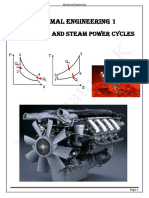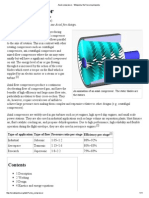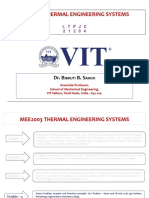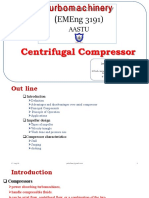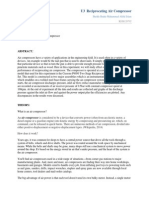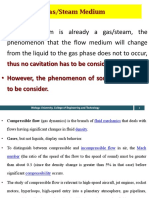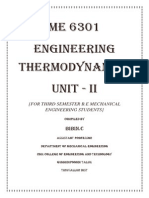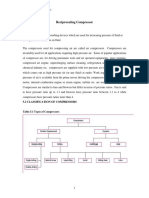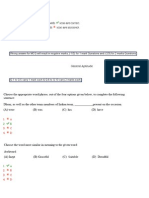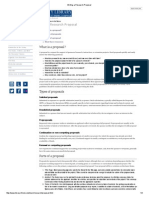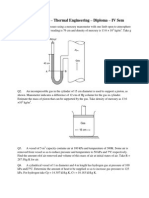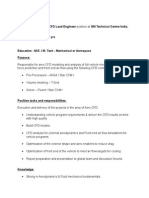Air Compressor Notes
Uploaded by
Irfan ShaikhAir Compressor Notes
Uploaded by
Irfan Shaikh706 ________________________________________________________ Applied Thermodynamics
16
Reciprocating and Rotary
Compressor
16.1 INTRODUCTION
Compressors are work absorbing devices which are used for increasing pressure of fluid at the expense
of work done on fluid.
The compressors used for compressing air are called air compressors. Compressors are invariably
used for all applications requiring high pressure air. Some of popular applications of compressor are, for
driving pneumatic tools and air operated equipments, spray painting, compressed air engine, supercharging
in internal combustion engines, material handling (for transfer of material), surface cleaning, refrigeration
and air conditioning, chemical industry etc. Compressors are supplied with low pressure air (or any
fluid) at inlet which comes out as high pressure air (or any fluid) at outlet, Fig. 16.1. Work required for
increasing pressure of air is available from the prime mover driving the compressor. Generally, electric
motor, internal combustion engine or steam engine, turbine etc. are used as prime movers. Compressors
are similar to fans and blowers but differ in terms of pressure ratios. Fan is said to have pressure ratio
up to 1.1 and blowers have pressure ratio between 1.1 and 4 while compressors have pressure ratios
more than 4.
Fig. 16.1 Compressor
Compressors can be classified in the following different ways.
(a) Based on principle of operation: Based on the principle of operation compressors can be
classified as,
(i) Positive displacement compressors
(ii) Non-positive displacement compressors
In positive displacement compressors the compression is realized by displacement of solid boundary
and preventing fluid by solid boundary from flowing back in the direction of pressure gradient. Due to
solid wall displacement these are capable of providing quite large pressure ratios. Positive displacement
compressors can be further classified based on the type of mechanism used for compression. These
can be
Reciprocating and Rotary Compressor ______________________________________________ 707
(i) Reciprocating type positive displacement compressors
(ii) Rotary type positive displacement compressors
Reciprocating compressors generally, employ piston-cylinder arrangement where displacement
of piston in cylinder causes rise in pressure. Reciprocating compressors are capable of giving large
pressure ratios but the mass handling capacity is limited or small. Reciprocating compressors may also
be single acting compressor or double acting compressor. Single acting compressor has one delivery
stroke per revolution while in double acting there are two delivery strokes per revolution of crank shaft.
Rotary compressors employing positive displacement have a rotary part whose boundary causes positive displacement of fluid and thereby compression. Rotary compressors of this type are available in the
names as given below;
(i) Roots blower
(ii) Vaned type compressors
Rotary compressors of above type are capable of running at higher speed and can handle large
mass flow rate than reciprocating compressors of positive displacement type.
Non-positive displacement compressors, also called as steady flow compressors use dynamic
action of solid boundary for realizing pressure rise. Here fluid is not contained in definite volume and
subsequent volume reduction does not occur as in case of positive displacement compressors. Nonpositive displacement compressor may be of axial flow type or centrifugal type depending upon type
of flow in compressor.
(b) Based on number of stages: Compressors may also be classified on the basis of number
of stages. Generally, the number of stages depend upon the maximum delivery pressure.
Compressors can be single stage or multistage. Normally maximum compression ratio of 5
is realized in single stage compressors. For compression ratio more than 5 the multi-stage
compressors are used.
Typical values of maximum delivery pressures generally available from different types of compressor are,
(i) Single stage compressor, for delivery pressure up to 5 bar
(ii) Two stage compressor, for delivery pressure between 5 and 35 bar
(iii) Three stage compressor, for delivery pressure between 35 and 85 bar
(iv) Four stage compressor, for delivery pressure more than 85 bar
(c) Based on capacity of compressors: Compressors can also be classified depending upon the
capacity of compressor or air delivered per unit time. Typical values of capacity for different
compressors are given as;
(i) Low capacity compressors, having air delivery capacity of 0.15 m3/s or less
(ii) Medium capacity compressors, having air delivery capacity between 0.15 and 5 m3/s.
(iii) High capacity compressors, having air delivery capacity more than 5 m3/s.
(d) Based on highest pressure developed: Depending upon the maximum pressure available from
compressor they can be classified as low pressure, medium pressure, high pressure and
super high pressure compressors. Typical values of maximum pressure developed for
different compressors are as under;
(i) Low pressure compressor, having maximum pressure up to 1 bar
(ii) Medium pressure compressor, having maximum pressure from 1 to 8 bar
(iii) High pressure compressor, having maximum pressure from 8 to 10 bar
(iv) Super high pressure compressor, having maximum pressure more than 10 bar.
708 ________________________________________________________ Applied Thermodynamics
16.2
RECIPROCATING COMPRESSORS
Reciprocating compressor has piston cylinder arrangement as shown in Fig. 16.2.
Fig. 16.2 Line diagram of reciprocating compressor
Reciprocating compressor has piston, cylinder, inlet valve, exit valve, connecting rod, crank,
piston pin, crank pin and crank shaft. Inlet valve and exit valves may be of spring loaded type which get
opened and closed due to pressure differential across them. Let us consider piston to be at top dead
centre (TDC) and move towards bottom dead centre (BDC). Due to this piston movement from TDC to
BDC suction pressure is created causing opening of inlet valve. With this opening of inlet valve and
suction pressure the atmospheric air enters the cylinder.
Air gets into cylinder during this stroke and is subsequently compressed in next stroke with both
inlet valve and exit valve closed. Both inlet valve and exit valves are of plate type and spring loaded so as
to operate automatically as and when sufficient pressure difference is available to cause deflection in
spring of valve plates to open them. After piston reaching BDC it reverses its motion and compresses the
air inducted in previous stroke. Compression is continued till the pressure of air inside becomes sufficient to cause deflection in exit valve. At the moment when exit valve plate gets lifted the exhaust of
compressed air takes place. This piston again reaches TDC from where downward piston movement is
again accompanied by suction. This is how reciprocating compressor keeps on working as flow device.
In order to counter for the heating of piston-cylinder arrangement during compression the provision of
cooling the cylinder is there in the form of cooling jackets in the body. Reciprocating compressor
described above has suction, compression and discharge as three prominent processes getting completed in two strokes of piston or one revolution of crank shaft.
Reciprocating and Rotary Compressor ______________________________________________ 709
16.3 THERMODYNAMIC ANALYSIS
Compression of air in compressor may be carried out following number of thermodynamic processes
such as isothermal compression, polytropic compression or adiabatic compression. Figure 16.3 shows
the thermodynamic cycle involved in compression. Theoretical cycle is shown neglecting clearance
volume but in actual cycle clearance volume can not be negligible. Clearance volume is necessary
in order to prevent collision of piston with cylinder head, accommodating valve mechanism etc.
Compression process is shown by process 12, 12, 12 following adiabatic, polytropic and isothermal
processes.
On p-V diagram process 41 shows the suction process followed by compression during 12
and discharge through compressor is shown by process 23.
Air enters compressor at pressure p1 and is compressed up to p2. Compression work requirement
can be estimated from the area below the each compression process. Area on pV diagram shows that
work requirement shall be minimum with isothermal process 12. Work requirement is maximum with
process 12 i.e. adiabatic process. As a designer one shall be interested in a compressor having minimum
compression work requirement. Therefore, ideally compression should occur isothermally for minimum
work input. In practice it is not possible to have isothermal compression because constancy of temperature
Fig. 16.3 Compression cycle on p-V diagram
during compression can not be realized. Generally, compressors run at substantially high speed while
isothermal compression requires compressor to run at very slow speed so that heat evolved during
compression is dissipated out and temperature remains constant. Actually due to high speed running of
compressor the compression process may be assumed to be near adiabatic or polytropic process following
law of compression as pV n = C with value of n varying between 1.25 and 1.35 for air. Compression
process following three processes is also shown on T-s diagram in Fig. 16.4. It is thus obvious that
actual compression process should be compared with isothermal compression process. A mathematical
parameter called isothermal efficiency is defined for quantifying the degree of deviation of actual
compression process from ideal compression process. Isothermal efficiency is defined by the ratio of
isothermal work and actual indicated work in reciprocating compressor.
710 ________________________________________________________ Applied Thermodynamics
Fig. 16.4 Compression process on T-s diagram
Isothermal efficiency =
Isothermal work
Actual indicated work
Practically, compression process is attempted to be closed to isothermal process by air/water
cooling, spraying cold water during compression process. In case of multi-stage compression process
the compression in different stages is accompanied by intercooling in between the stages.
Mathematically, for the compression work following polytropic process, pV n = C. Assuming
negligible clearance volume the cycle work done,
Wc = Area on p-V diagram
LM FG p V - p V IJ OP p V
N H n -1 KQ
F n IJ [p V p V ]
=G
H n -1K
F n IJ (p V ) LM p V - 1OP
=G
H n -1K
N pV Q
F n IJ (p V ) LMF p I - 1OP
W =G
H n -1K
MNH p K
PQ
F n IJ (mRT ) LMF p I - 1OP
W = GH
n -1K
MNH p K
PQ
F n IJ mR (T T )
W =G
H n -1K
= p2 V2 +
2 2
1 1
1 1
2 2
1 1
2 2
1 1
1 1
( n - 1)
n
1 1
or,
( n - 1)
n
In case of compressor having isothermal compression process, n = 1, i.e. p1V1 = p1V2
Wc, iso = p2V2 + p1V1 ln r p1V1
Reciprocating and Rotary Compressor ______________________________________________ 711
Wc,
iso
= p1V1 ln r, where r =
V1
V2
In case of compressor having adiabatic compression process, n = g
Wc, adiabatic =
FG g IJ mR (T
H g -1K
T1)
or,
Wc, adiabatic = mCp (T2 T1)
Wc, adiabatic = m (h2 h1)
Hence, isothermal efficiency,
p1V1 ln r
F n I a p V f LMF p I
H n - 1 K MNH p K
hiso =
1 1
( n - 1)
n
OP
PQ
-1
The isothermal efficiency of a compressor should be close to 100% which means that actual
compression should occur following a process close to isothermal process. For this the mechanism be
derived to maintain constant temperature during compression process. Different arrangements which
can be used are:
(i) Faster heat dissipation from inside of compressor to outside by use of fins over cylinder.
Fins facilitate quick heat transfer from air being compressed to atmosphere so that
temperature rise during compression can be minimized.
(ii) Water jacket may be provided around compressor cylinder so that heat can be picked by
cooling water circulating through water jacket. Cooling water circulation around compressor
regulates rise in temperature to great extent.
(iii) The water may also be injected at the end of compression process in order to cool the air
being compressed. This water injection near the end of compression process requires special
arrangement in compressor and also the air gets mixed with water and needs to be separated
out before being used. Water injection also contaminates the lubricant film on inner surface
of cylinder and may initiate corrosion etc. The water injection is not popularly used.
(iv) In case of multistage compression in different compressors operating serially, the air leaving
one compressor may be cooled up to ambient state or somewhat high temperature before
being injected into subsequent compressor. This cooling of fluid being compressed between
two consecutive compressors is called intercooling and is frequently used in case of
multistage compressors.
Considering clearance volume: With clearance volume the cycle is represented on Fig. 16.3 (b).
The work done for compression of air polytropically can be given by the area enclosed in cycle 123
4. Clearance volume in compressors varies from 1.5% to 35% depending upon type of compressor.
Wc, with CV = Area1234
F n IJ (p V ) LMF p I
=G
H n -1K
MNH p K
2
1 1
Here
p1 = p4, p2 = p3
( n - 1)
n
O F n I
- 1P G
PQ H n - 1 JK (p V )
4 4
LMF p I
MNH p K
3
4
( n - 1)
n
OP
PQ
-1
712 ________________________________________________________ Applied Thermodynamics
Wc, with CV
Wc, with CV
F n IJ (p V ) LMF p I
=G
H n -1K
MNH p K
F n IJ p LMF p I
=G
H n - 1 K MNH p K
1 1
1 4
O F n I
LMF p I
- 1P G
(p
V
)
PQ H n - 1 JK
MNH p K
O
- 1P (V V )
PQ
( n - 1)
n
( n - 1)
n
( n - 1)
n
OP
PQ
-1
In the cylinder of reciprocating compressor (V1 V4) shall be the actual volume of air delivered
per cycle. Vd = V1 V4. This (V1 V4) is actually the volume of air inhaled in the cycle and delivered
subsequently.
Wc, with CV =
FG n IJ p V
H n -1K
1 d
LMF p I
MNH p K
2
OP
PQ
n-1
n
-1
If air is considered to behave as perfect gas then pressure, temperature, volume and mass can be
inter related using perfect gas equation. The mass at state 1 may be given as m1, mass at state 2 shall be
m1, but at state 3 after delivery mass reduces to m2 and at state 4 it shall be m2.
So,
at state 1, p1V1 = m1RT1
at state 2, p2V2 = m1RT2
at state 3, p3V3 = m2RT3 or, p2V3 = m2RT3
at state 4, p4V4 = m2RT4, or p1V4 = m2RT4
Ideally there shall be no change in temperature during suction and delivery i.e., T4 = T1 and
T2 = T3. From earlier equation,
Wc, with CV
F n IJ p
= G
H n -1K
(V1
Temperature and pressure can be related as,
Fp I
HpK
FG p IJ
Hp K
2
( n - 1)
n
and
( n - 1)
n
T2
T1
T
= 4
T3
Substituting,
FpI
Hp K
1
LF p I
V) M
MNH p K
( n - 1)
n
( n - 1)
n
OP
PQ
-1
T4
T3
LM T - 1OP
NT Q
Substituting for constancy of temperature during suction and delivery.
F n IJ (m RT m RT ) LM T - T OP
= G
W
H n -1K
N T Q
Wc, with CV =
FG n IJ (m RT
H n -1K
1
m2RT4)
2
1
c, with CV
or,
Wc, with CV =
FG n IJ (m
H n -1K
m2) R(T2 T1)
Reciprocating and Rotary Compressor ______________________________________________ 713
Thus, (m1 m2) denotes the mass of air sucked or delivered. For unit mass of air delivered the
work done per kg of air can be given as,
Wc, with CV =
FG n IJ R(T
H n -1K
T1), per kg of air
Thus from above expressions it is obvious that the clearance volume reduces the effective swept
volume i.e. the mass of air handled but the work done per kg of air delivered remains unaffected.
From the cycle work estimated as above the theoretical power required for running compressor
shall be as given ahead.
For single acting compressor running with N rpm, power input required, assuming clearance
volume.
LMF n I
R|F p I
U|OP
p
V
V
1
a
f
Power required =
S|H p K
V|P N
MNH n - 1 K
T
WQ
LMF n I
R|F p I
p
V
V
a
f
for double acting compressor, power =
S|H p K
MNH n - 1 K
T
2
( n - 1)
n
( n - 1)
n
U|OP
V|P 2N
WQ
-1
Volumetric efficiency: Volumetric efficiency of compressor is the measure of the deviation from
volume handling capacity of compressor. Mathematically, the volumetric efficiency is given by the ratio
of actual volume of air sucked and swept volume of cylinder. Ideally the volume of air sucked should be
equal to the swept volume of cylinder, but it is not so in actual case. Practically the volumetric efficiency
lies between 60 and 90%.
Volumetric efficiency can be overall volumetric efficiency and absolute volumetric efficiency
as given below:
Volume of free air sucked into cylinder
Overall volumetric efficiency =
Swept volume of LP cylinder
or
(Volumetric efficiency
referred to free air conditions) =
F
GH
(Mass of air delivered per unit time )
Mass of air corresponding toswept
volume of LP cylinder per unit time
for free air conditions
I
JK
Here free air condition refers to the standard conditions. Free air condition may be taken as 1 atm
or 1.01325 bar and 15C or 288 K. Consideration for free air is necessary as otherwise the different
compressors can not be compared using volumetric efficiency because specific volume or density of air
varies with altitude. It may be seen that a compressor at datum level (sea level) shall deliver large mass
than the same compressor at high altitude.
This concept is used for giving the capacity of compressor in terms of free air delivery (FAD).
Free air delivery is the volume of air delivered being reduced to free air conditions. In case of air the
free air delivery can be obtained using perfect gas equation as,
714 ________________________________________________________ Applied Thermodynamics
pa Va
p V - V4
= 1 1
Ta
T1
p2 V2 - V3
T2
where subscript a or pa, Va, Ta denote properties at free air conditions
p1 Ta V1 - V4
= FAD per cycle.
pa T1
This volume Va gives free air delivered per cycle by the compressor.
Absolute volumetric efficiency can be defined, using NTP conditions in place of free air condi-
Va =
or,
tions.
Volume of air sucked into cylinder at NTP
Swept volume of LP cylinder
( Mass of air delivered per unit time )
=
Massof air corresponding to swept volume
of LP cylinder per unit time estimated at NTP
Thus, volumetric efficiency referred to free air conditions.
Volume of air sucked referred to freeair conditions ( FAD )
hvol. =
Swept volume
Absolute volumetric efficiency =
=
=
hvol. =
Here,
and
Va
V1 - V3
a
a
p1Ta V1 - V4
pa T1 V1 - V3
f
f
F p T I RS aV + V f - V UV .
HpTK T V W
1 a
a 1
Vs is swept volume, Vs = V1 V3
Vc is clearance volume, Vc = V 3
hvol. =
Here,
F p T I RS1 + FG V IJ - FG V IJ UV
H p T K T H V K H V KW
1 a
a 1
V4
V V
= 4 c
Vs
Vc Vs
V4 Vc
=
V3 Vs
FG
H
IJ
K
Let the ratio of clearance volume to swept volume be given by C.i.e.
FG p T IJ RS1 + C - C FG V IJ UV
HpTK T
H V KW
F p T IJ RS1 + C - C FG p IJ UV
=G
H p T K |T
H p K |W
hvol. =
1 a
a 1
1/ n
or,
hvol.
1 a
a 1
Vc
= C.
Vs
Reciprocating and Rotary Compressor ______________________________________________ 715
Volumetric efficiency depends on ambient pressure and temperature, suction pressure and temperature, ratio of clearance to swept volume, and pressure limits. Volumetric efficiency increases with
decrease in pressure ratio in compressor.
16.4 ACTUAL INDICATOR DIAGRAM
Theoretical indicator diagram of reciprocating compressor as shown in earlier discussion refers to the
ideal state of operation of compressor. The practical limitations, when considered in the indicator diagram yield actual indicator diagram as shown in Fig. 16.5.
Fig. 16.5 Actual indicator diagram
Actual p-V diagram varies from theoretical p-V diagram due to following: Compressor has
mechanical types of valves so the instantaneous opening and closing of valves can never be achieved.
Also during suction and discharge there occurs throttling due to reduction in area of flow across inlet
and exit valve. 123 4 shows theoretical indicator diagram and actual indicator diagram is shown by
1234 on p-V diagram. Compression process 12 ends at state 2. At state 2 exit valve should open
instantaneously which does not occur and also due to restricted opening there shall be throttling causing
drop in pressure. Due to time lag in opening of exit valve compression process is continued up to 2.
Thus, additional work is done during delivery from compressor as shown by hatched area 2 23.
After delivery stroke the inlet valve should theoretically open at 4 but does not open at this point
instead is opened fully at 4. Shift from state 4 to 4 is there due to inertia in opening of valve throttling,
gradual opening, and friction losses etc. Thus it is seen that during suction there occurs intake depression as shown in actual indicator diagram. Work required as shown in actual indicator diagram is
more than theoretical diagram. In order to have compressor close to ideal compressor with minimum
losses it shall be desired to have actual indicator diagram close to theoretical diagram, which requires
less inertia and efficient operation of valves. Friction losses in pipings and across valves should be
minimized.
You might also like
- Mitchell-Ford Econoline 1992-2010 Factory Workshop Service Repair Manual50% (2)Mitchell-Ford Econoline 1992-2010 Factory Workshop Service Repair Manual3,346 pages
- Manual Reparacion Mitsubishi Mirage 2000 PART 1No ratings yetManual Reparacion Mitsubishi Mirage 2000 PART 1541 pages
- G700B Operators - Manual - 21 1 434 4006 TR - Co PDF100% (2)G700B Operators - Manual - 21 1 434 4006 TR - Co PDF238 pages
- Module 5: Lecture 1: Compressor: Classification, Reciprocating Compressor100% (1)Module 5: Lecture 1: Compressor: Classification, Reciprocating Compressor21 pages
- Chapter 16 Solutions-Applied Thermodynamics and Engineering 5th EditionNo ratings yetChapter 16 Solutions-Applied Thermodynamics and Engineering 5th Edition10 pages
- Turbo Machinery, Lecture Notes Physics Prof T P Hynes100% (2)Turbo Machinery, Lecture Notes Physics Prof T P Hynes71 pages
- Axial Compressor - Wikipedia, The Free EncyclopediaNo ratings yetAxial Compressor - Wikipedia, The Free Encyclopedia11 pages
- Air Compressor: Introduction - Equations - ApplicationNo ratings yetAir Compressor: Introduction - Equations - Application51 pages
- C Module-5 Reciprocating Air Compressors. Reciprocating Compressors - Construction - Working100% (1)C Module-5 Reciprocating Air Compressors. Reciprocating Compressors - Construction - Working48 pages
- 08-Positive Displacement Compressors PDFNo ratings yet08-Positive Displacement Compressors PDF105 pages
- Performance Test On Petrol Engine Eddy Current DynamometerNo ratings yetPerformance Test On Petrol Engine Eddy Current Dynamometer6 pages
- Single Stage Single Acting Reciprocating Air Compressor100% (3)Single Stage Single Acting Reciprocating Air Compressor3 pages
- Compressors, Gas Dynamics and Gas Turbines MCQ100% (1)Compressors, Gas Dynamics and Gas Turbines MCQ11 pages
- Interview Questions Engineering MechanicalNo ratings yetInterview Questions Engineering Mechanical5 pages
- Me 6301 Engineering Thermodynamics Short Questions and Answers - Unit 2No ratings yetMe 6301 Engineering Thermodynamics Short Questions and Answers - Unit 27 pages
- Lecture 04 First Law of Thermodynamics - Control VolumesNo ratings yetLecture 04 First Law of Thermodynamics - Control Volumes32 pages
- Inlet Flow Distortion in A Centrifugal CompressorNo ratings yetInlet Flow Distortion in A Centrifugal Compressor110 pages
- Steady-Flow Systems & Engineering DevicesNo ratings yetSteady-Flow Systems & Engineering Devices74 pages
- Gas Dynamics and Jet Propulsion - Lecture Notes, Study Material and Important Questions, AnswersNo ratings yetGas Dynamics and Jet Propulsion - Lecture Notes, Study Material and Important Questions, Answers4 pages
- Reciprocating Compressor: DR - Pundarika, BMSCE, BangaloreNo ratings yetReciprocating Compressor: DR - Pundarika, BMSCE, Bangalore20 pages
- Question Bank-Static and Strength of Material - Module 3 - B.archNo ratings yetQuestion Bank-Static and Strength of Material - Module 3 - B.arch8 pages
- General Aptitude: Answer: Exp: For A Match To Be Played, We Need 2 TeamsNo ratings yetGeneral Aptitude: Answer: Exp: For A Match To Be Played, We Need 2 Teams24 pages
- Question Bank-Static and Strength of Material - Module 3 - B.archNo ratings yetQuestion Bank-Static and Strength of Material - Module 3 - B.arch6 pages
- Question Bank Thermal Engineering UPDATEDNo ratings yetQuestion Bank Thermal Engineering UPDATED6 pages
- Strength of Material - Diploma - IV Semester Question BankNo ratings yetStrength of Material - Diploma - IV Semester Question Bank4 pages
- Course Objective - Internal Combustion EngineNo ratings yetCourse Objective - Internal Combustion Engine1 page
- Strength of Material - Diploma - IV Semester Question BankNo ratings yetStrength of Material - Diploma - IV Semester Question Bank4 pages
- Study On Customer Perception of Royal Enfield100% (1)Study On Customer Perception of Royal Enfield79 pages
- Restor: Endless Opportunities For Profit in Flathead, Marine, Ag and Vintage Engine WorkNo ratings yetRestor: Endless Opportunities For Profit in Flathead, Marine, Ag and Vintage Engine Work12 pages
- Allison MD/B 300/B 400 Series On-Highway Transmissions Parts CatalogNo ratings yetAllison MD/B 300/B 400 Series On-Highway Transmissions Parts Catalog9 pages
- Rolls Royce and Bentley Production Milestones100% (1)Rolls Royce and Bentley Production Milestones2 pages
- (Sujun Kim) Final NationalSeminar ID Battery Industry Deloitte VF2No ratings yet(Sujun Kim) Final NationalSeminar ID Battery Industry Deloitte VF224 pages
- Technical Data Sheet Technical Data Sheet Technical Data Sheet Technical Data Sheet JD 30 M JD 30 M JD 30 M JD 30 MNo ratings yetTechnical Data Sheet Technical Data Sheet Technical Data Sheet Technical Data Sheet JD 30 M JD 30 M JD 30 M JD 30 M6 pages
- PM 8W-80 Connector Pin-Outs 8W - 80 - 69No ratings yetPM 8W-80 Connector Pin-Outs 8W - 80 - 693 pages
- HVAC Equations, Data, and Rules of Thumb, Third EditionFrom EverandHVAC Equations, Data, and Rules of Thumb, Third Edition
- Mitchell-Ford Econoline 1992-2010 Factory Workshop Service Repair ManualMitchell-Ford Econoline 1992-2010 Factory Workshop Service Repair Manual
- G700B Operators - Manual - 21 1 434 4006 TR - Co PDFG700B Operators - Manual - 21 1 434 4006 TR - Co PDF
- Module 5: Lecture 1: Compressor: Classification, Reciprocating CompressorModule 5: Lecture 1: Compressor: Classification, Reciprocating Compressor
- Chapter 16 Solutions-Applied Thermodynamics and Engineering 5th EditionChapter 16 Solutions-Applied Thermodynamics and Engineering 5th Edition
- Turbo Machinery, Lecture Notes Physics Prof T P HynesTurbo Machinery, Lecture Notes Physics Prof T P Hynes
- Axial Compressor - Wikipedia, The Free EncyclopediaAxial Compressor - Wikipedia, The Free Encyclopedia
- Air Compressor: Introduction - Equations - ApplicationAir Compressor: Introduction - Equations - Application
- C Module-5 Reciprocating Air Compressors. Reciprocating Compressors - Construction - WorkingC Module-5 Reciprocating Air Compressors. Reciprocating Compressors - Construction - Working
- Performance Test On Petrol Engine Eddy Current DynamometerPerformance Test On Petrol Engine Eddy Current Dynamometer
- Single Stage Single Acting Reciprocating Air CompressorSingle Stage Single Acting Reciprocating Air Compressor
- Me 6301 Engineering Thermodynamics Short Questions and Answers - Unit 2Me 6301 Engineering Thermodynamics Short Questions and Answers - Unit 2
- Lecture 04 First Law of Thermodynamics - Control VolumesLecture 04 First Law of Thermodynamics - Control Volumes
- Gas Dynamics and Jet Propulsion - Lecture Notes, Study Material and Important Questions, AnswersGas Dynamics and Jet Propulsion - Lecture Notes, Study Material and Important Questions, Answers
- Reciprocating Compressor: DR - Pundarika, BMSCE, BangaloreReciprocating Compressor: DR - Pundarika, BMSCE, Bangalore
- Question Bank-Static and Strength of Material - Module 3 - B.archQuestion Bank-Static and Strength of Material - Module 3 - B.arch
- General Aptitude: Answer: Exp: For A Match To Be Played, We Need 2 TeamsGeneral Aptitude: Answer: Exp: For A Match To Be Played, We Need 2 Teams
- Question Bank-Static and Strength of Material - Module 3 - B.archQuestion Bank-Static and Strength of Material - Module 3 - B.arch
- Strength of Material - Diploma - IV Semester Question BankStrength of Material - Diploma - IV Semester Question Bank
- Strength of Material - Diploma - IV Semester Question BankStrength of Material - Diploma - IV Semester Question Bank
- Restor: Endless Opportunities For Profit in Flathead, Marine, Ag and Vintage Engine WorkRestor: Endless Opportunities For Profit in Flathead, Marine, Ag and Vintage Engine Work
- Allison MD/B 300/B 400 Series On-Highway Transmissions Parts CatalogAllison MD/B 300/B 400 Series On-Highway Transmissions Parts Catalog
- (Sujun Kim) Final NationalSeminar ID Battery Industry Deloitte VF2(Sujun Kim) Final NationalSeminar ID Battery Industry Deloitte VF2
- Technical Data Sheet Technical Data Sheet Technical Data Sheet Technical Data Sheet JD 30 M JD 30 M JD 30 M JD 30 MTechnical Data Sheet Technical Data Sheet Technical Data Sheet Technical Data Sheet JD 30 M JD 30 M JD 30 M JD 30 M
















